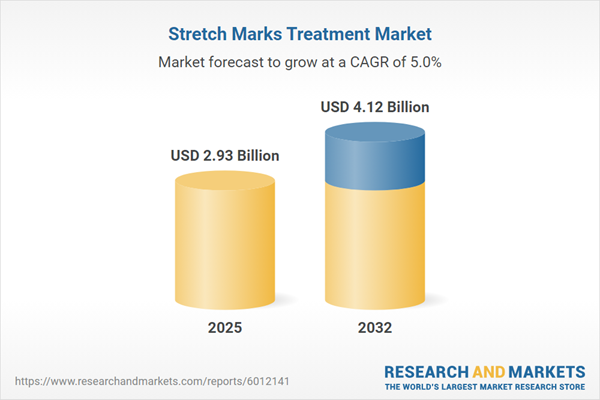Speak directly to the analyst to clarify any post sales queries you may have.
The stretch marks treatment market is undergoing significant change as patient requirements evolve and new medical technologies reshape standards of care. Companies are shifting strategic focus to ensure relevance and competitiveness in this innovation-driven sector.
Market Snapshot: Stretch Marks Treatment Market Size and Growth
In 2024, the global stretch marks treatment market reached a valuation of USD 2.78 billion and is set to advance to USD 2.93 billion in 2025, achieving a 5% compound annual growth rate (CAGR). This momentum is fueled by growing adoption of advanced therapies, continuous expansion of product portfolios, and a robust innovation pipeline among leading manufacturers. Growth is also driven by the emergence of diverse solutions, including device-assisted options, topical and oral formulations, and the integration of digital health platforms. These trends are broadening both patient access and therapeutic effectiveness, intensifying competition, and prompting organizations to refine market intelligence and strategic flexibility in line with sector shifts.
Scope & Segmentation: Market Landscape and Participant Dynamics
- Product Types: Bioactive creams, both natural and synthetic, along with advanced therapeutic gels, adhesive patch systems, and laser-based devices, offer prevention and intervention across clinical and home settings. Each product category caters to various application needs and levels of care support.
- Distribution Channels: Dermatology clinics, hospitals, multi-specialty centers, retail pharmacies, and online platforms provide a wide spectrum of access for both institutional and individual buyers, supporting the uptake of new innovations and established treatments.
- End Users: Dermatology centers, integrated hospital networks, and organizations geared toward at-home care are prominent consumers, with a focus on personalized, adaptable treatment approaches for differing patient needs.
- Application Routes: Device-assisted applications, topical products, and oral therapies create a multi-modal delivery environment, enabling both self-managed care and provider-led interventions for optimal engagement and flexibility.
- Regions: Presence in North America, Europe, Asia-Pacific, Latin America, the Middle East, and Africa brings diverse regulatory, healthcare, and investment contexts, each contributing unique factors that shape both product adoption and competitive behavior across the stretch marks treatment market.
- Market Coverage: Notable market participants such as Johnson & Johnson, L'Oréal S.A., Beiersdorf AG, Unilever PLC, The Procter & Gamble Company, Estée Lauder Companies, Shiseido Company, Kao Corporation, Reckitt Benckiser Group, and Colgate-Palmolive Company reinforce competitive intensity through innovation, portfolio enhancement, and significant investment in research and new product development.
Key Takeaways: Strategic Insights for Decision-Makers
- Combining device-based solutions with traditional therapies extends market scope while facilitating more tailored care across clinical environments and home-based settings.
- Maintaining transparent sourcing and clear product formulations builds trust among procurement teams and enhances positioning in markets with heightened scrutiny.
- Proactive monitoring of regulatory shifts and swift adaptation allow organizations to respond effectively to evolving compliance and market access requirements worldwide.
- Adoption of digital healthcare platforms, such as teledermatology and remote monitoring, increases patient engagement and supports improved provider–patient collaboration.
- Resilient multi-regional supply chains decrease disruption risks and help sustain product availability and pricing amidst market fluctuations.
- Strategic alliances and acquisitions expand organizational capabilities, strengthening both global reach and responsiveness to changing market dynamics at the local level.
Tariff Impact: Regulatory and Supply Chain Considerations in the United States
Recent tariff measures in the United States have lifted costs for imported devices and key product ingredients. In response, companies are prioritizing domestic production and diversifying sources of supply. Adaptive procurement strategies and comprehensive risk management are now critical in sustaining product flow and managing regulatory complexity in shifting trade conditions.
Methodology & Data Sources
This report synthesizes findings from extensive secondary research, including scientific literature, regulatory reviews, and patent analysis. Expert interviews with dermatology professionals and procurement executives, supported by scenario assessment and targeted surveys, ensure data rigor and relevance.
Why This Report Matters
- Provides executives with practical insights to monitor market developments, anticipate regulatory actions, and inform strategic adjustments within the stretch marks treatment market.
- Clarifies procurement risk factors and regulatory exposures, helping leaders identify sustainable growth opportunities.
- Equips organizations with reliable data to evaluate potential partners and pursue gains in both mature and emerging segments.
Conclusion
This report supports market leaders in refining strategies, improving responsiveness, and preparing confidently for ongoing changes in the stretch marks treatment landscape.
Additional Product Information:
- Purchase of this report includes 1 year online access with quarterly updates.
- This report can be updated on request. Please contact our Customer Experience team using the Ask a Question widget on our website.
Table of Contents
3. Executive Summary
4. Market Overview
7. Cumulative Impact of Artificial Intelligence 2025
Companies Mentioned
The companies profiled in this Stretch Marks Treatment market report include:- Johnson & Johnson
- L'Oréal S.A.
- Beiersdorf AG
- Unilever PLC
- The Procter & Gamble Company
- Estée Lauder Companies, Inc.
- Shiseido Company, Limited
- Kao Corporation
- Reckitt Benckiser Group plc
- Colgate-Palmolive Company
Table Information
| Report Attribute | Details |
|---|---|
| No. of Pages | 197 |
| Published | October 2025 |
| Forecast Period | 2025 - 2032 |
| Estimated Market Value ( USD | $ 2.93 Billion |
| Forecasted Market Value ( USD | $ 4.12 Billion |
| Compound Annual Growth Rate | 5.0% |
| Regions Covered | Global |
| No. of Companies Mentioned | 11 |









